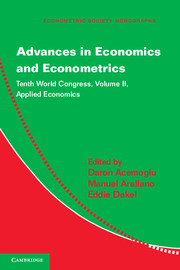Book contents
- Frontmatter
- Contents
- Contributors
- Preface
- I FINANCE
- II POLITICAL ECONOMY
- III MACROECONOMICS
- IV TRADE AND FIRM DYNAMICS
- V GROWTH
- VI FRISCH LECTURE
- VII PERSPECTIVES ON CHINESE ECONOMIC GROWTH
- 12 The China Miracle Demystified
- 13 Is Precocious Export Sophistication a Source of China's Growth Success? Computing the Share of Domestic Value Added in Exports When Processing Trade Is Prevalent
- 14 Perspectives on China's Economic Growth
- Name Index
- Miscellaneous Endmatter
12 - The China Miracle Demystified
Published online by Cambridge University Press: 05 May 2013
- Frontmatter
- Contents
- Contributors
- Preface
- I FINANCE
- II POLITICAL ECONOMY
- III MACROECONOMICS
- IV TRADE AND FIRM DYNAMICS
- V GROWTH
- VI FRISCH LECTURE
- VII PERSPECTIVES ON CHINESE ECONOMIC GROWTH
- 12 The China Miracle Demystified
- 13 Is Precocious Export Sophistication a Source of China's Growth Success? Computing the Share of Domestic Value Added in Exports When Processing Trade Is Prevalent
- 14 Perspectives on China's Economic Growth
- Name Index
- Miscellaneous Endmatter
Summary
When China began its transition from a planned to a market-oriented economy in 1979, it was a poor, inward-looking country with a per-capita income of US$182 and a trade dependence (i.e., trade-to-GDP) ratio of 11.2 percent. China's economic performance since then has been miraculous. Annual GDP growth averaged 9.9 percent in the 30-year period, and 16.3 percent in annual growth in international trade. China is now a middle-income country, with a per-capita GDP of US$3,688 in 2009; More than 600 million people have escaped poverty. Its trade dependence ratio has reached 65 percent, the highest among the world's large economies. In 2009, China overtook Japan as the world's second largest economy and replaced Germany as the world's largest exporter of merchandise. China's automobile market is now the world's largest, and Shanghai has been the world's busiest seaport by cargo tonnage since 2005. The spectacular growth in the past three decades far exceeded anyone's expectations at the outset of the transition, including Deng Xiaoping, the architect of China's reform and opening-up strategy.
Interest among academics in China's transition and development experience has increased exponentially in the past three decades. In this chapter, I provide answers to five related questions: Why was it possible for China to achieve such extraordinary performance during its transition? Why was China unable to attain similar success before its transition started? Why did most other transition economies, both socialist and nonsocialist, fail to achieve a similar performance?
- Type
- Chapter
- Information
- Advances in Economics and EconometricsTenth World Congress, pp. 505 - 518Publisher: Cambridge University PressPrint publication year: 2013



